Understanding Autism Spectrum Disorder: A Guide for Teachers
VerifiedAdded on 2023/04/11
|20
|4191
|291
AI Summary
This information booklet provides a comprehensive guide for teachers on understanding autism spectrum disorder (ASD) and effectively educating children with ASD. It covers the characteristics of ASD, challenges in social interactions and communication, and behavioral differences. The booklet also offers important steps for teachers to become masters in educating children with ASD, including educating oneself, reaching out to parents, and preparing the classroom. It emphasizes the importance of managing behavioral challenges and provides strategies for reducing the frequency and intensity of problematic behaviors. Overall, this guide aims to help teachers create a supportive and inclusive learning environment for children with ASD.
Contribute Materials
Your contribution can guide someone’s learning journey. Share your
documents today.
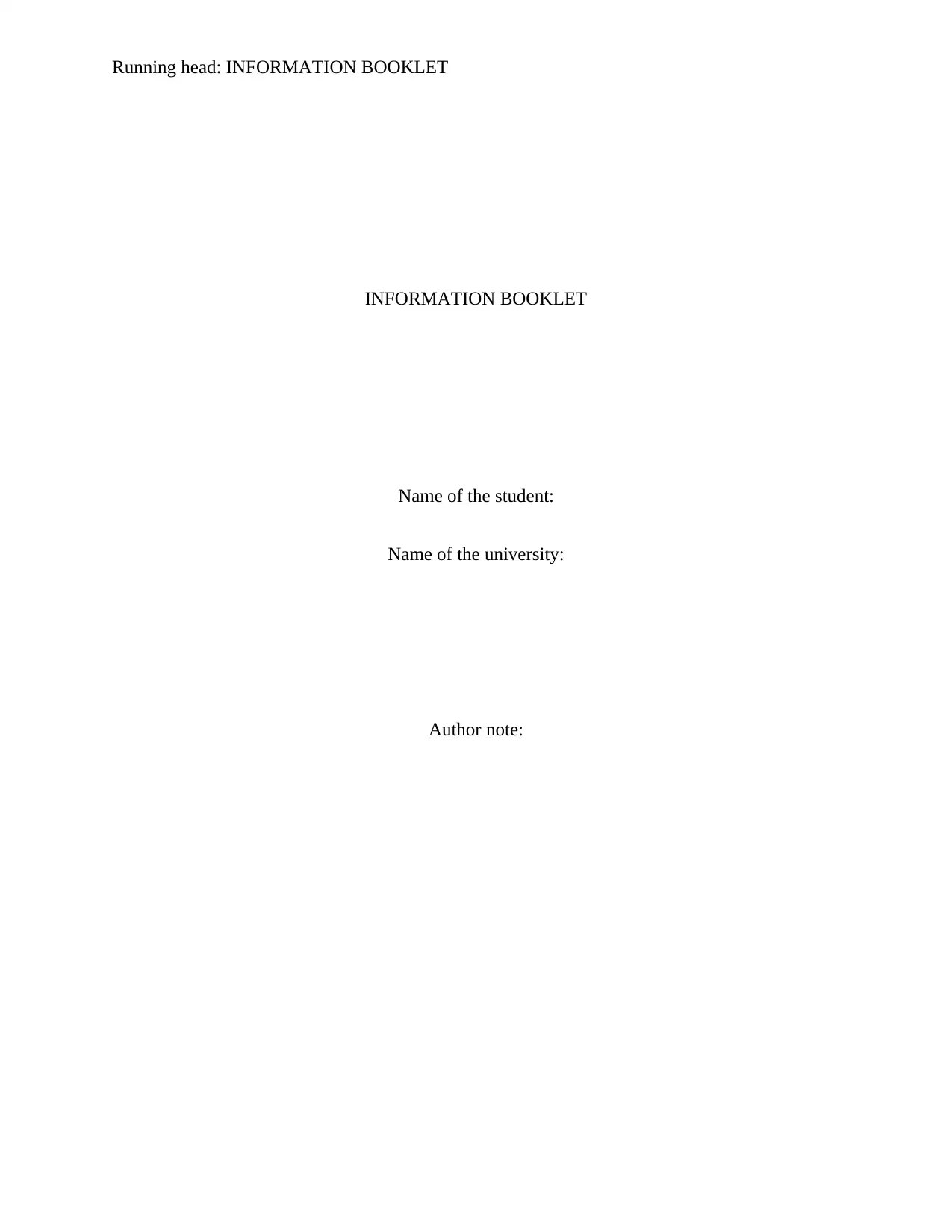
Running head: INFORMATION BOOKLET
INFORMATION BOOKLET
Name of the student:
Name of the university:
Author note:
INFORMATION BOOKLET
Name of the student:
Name of the university:
Author note:
Secure Best Marks with AI Grader
Need help grading? Try our AI Grader for instant feedback on your assignments.

1
INFORMATION BOOKLET
Autism spectrum disorder:
Autism can be explained as the neurological disorder that appears in individuals by three
years of age. Symptoms of autism mainly comprise of defects in three major development areas
among children and impact their abilities (Laghi et al., 2016). The issues are found in
successfully engaging in reciprocal social interactions, effective communication with different
other people in a developmentally appropriate manners and participating in range of activates as
well as behaviors that are typical of the age and the stage of development of the child. It must be
however remembered by every teachers that no two children with autism would be similar. More
boys are affected than girls with autism and the ratio mainly follows a value of about 4.1.children
with autism can be found in all cultures, societies as well as economic groups.
The term autism spectrum disorder is not a medical term but is mainly utilized for
describing three types of disorder. These are Autism, Asperger Syndrome, and PDD-NOS. these
are mainly because all these disorders share some of the most common characteristics that can be
manifested on the continuum from mild to severe (Sparapani et al., 2016).
Common characteristics present in children with autism:
Different challenges during social interactions:
Children may face challenges in interpreting various non-verbal languages
They may have difficulty in pretend playing
They may have poor eye gaze as well as avoidance of eye contact (Laghi et al., 2016)
They have difficulty understanding the perspective of others or how their behavior affects
others
INFORMATION BOOKLET
Autism spectrum disorder:
Autism can be explained as the neurological disorder that appears in individuals by three
years of age. Symptoms of autism mainly comprise of defects in three major development areas
among children and impact their abilities (Laghi et al., 2016). The issues are found in
successfully engaging in reciprocal social interactions, effective communication with different
other people in a developmentally appropriate manners and participating in range of activates as
well as behaviors that are typical of the age and the stage of development of the child. It must be
however remembered by every teachers that no two children with autism would be similar. More
boys are affected than girls with autism and the ratio mainly follows a value of about 4.1.children
with autism can be found in all cultures, societies as well as economic groups.
The term autism spectrum disorder is not a medical term but is mainly utilized for
describing three types of disorder. These are Autism, Asperger Syndrome, and PDD-NOS. these
are mainly because all these disorders share some of the most common characteristics that can be
manifested on the continuum from mild to severe (Sparapani et al., 2016).
Common characteristics present in children with autism:
Different challenges during social interactions:
Children may face challenges in interpreting various non-verbal languages
They may have difficulty in pretend playing
They may have poor eye gaze as well as avoidance of eye contact (Laghi et al., 2016)
They have difficulty understanding the perspective of others or how their behavior affects
others

2
INFORMATION BOOKLET
They have few facial expressions and face issues in understanding the facial expression
of others
Communication challenges faced by the individuals:
They face delay in different expressive as well as receptive language and may not speak
at all
They also have very literal understanding of speech and they are also found to face
difficulty in picking up on the different nuances (Stokes et al., 2017)
They may suffer from echolalia where they may have to repeat last words heard even
without providing any regards to the meaning
Behavioral differences that are faced by the individuals:
They show unusually intensified as well as restricted interests in a number of objects like
maps, dates, coins, numbers and others
They show unusual repetitive behaviors that may be both verbal as well as non-verbal
and are seen to include hand flapping as well as rocking (Morgan et al., 2018)
They are found to unusually sensitive towards various sensations and might be more or
less than any typical students
They may face issues with transitions and need for sameness
They may also exhibit aggressive and even disruptive self-injurious behavior being
unaware of any possible dangers.
INFORMATION BOOKLET
They have few facial expressions and face issues in understanding the facial expression
of others
Communication challenges faced by the individuals:
They face delay in different expressive as well as receptive language and may not speak
at all
They also have very literal understanding of speech and they are also found to face
difficulty in picking up on the different nuances (Stokes et al., 2017)
They may suffer from echolalia where they may have to repeat last words heard even
without providing any regards to the meaning
Behavioral differences that are faced by the individuals:
They show unusually intensified as well as restricted interests in a number of objects like
maps, dates, coins, numbers and others
They show unusual repetitive behaviors that may be both verbal as well as non-verbal
and are seen to include hand flapping as well as rocking (Morgan et al., 2018)
They are found to unusually sensitive towards various sensations and might be more or
less than any typical students
They may face issues with transitions and need for sameness
They may also exhibit aggressive and even disruptive self-injurious behavior being
unaware of any possible dangers.
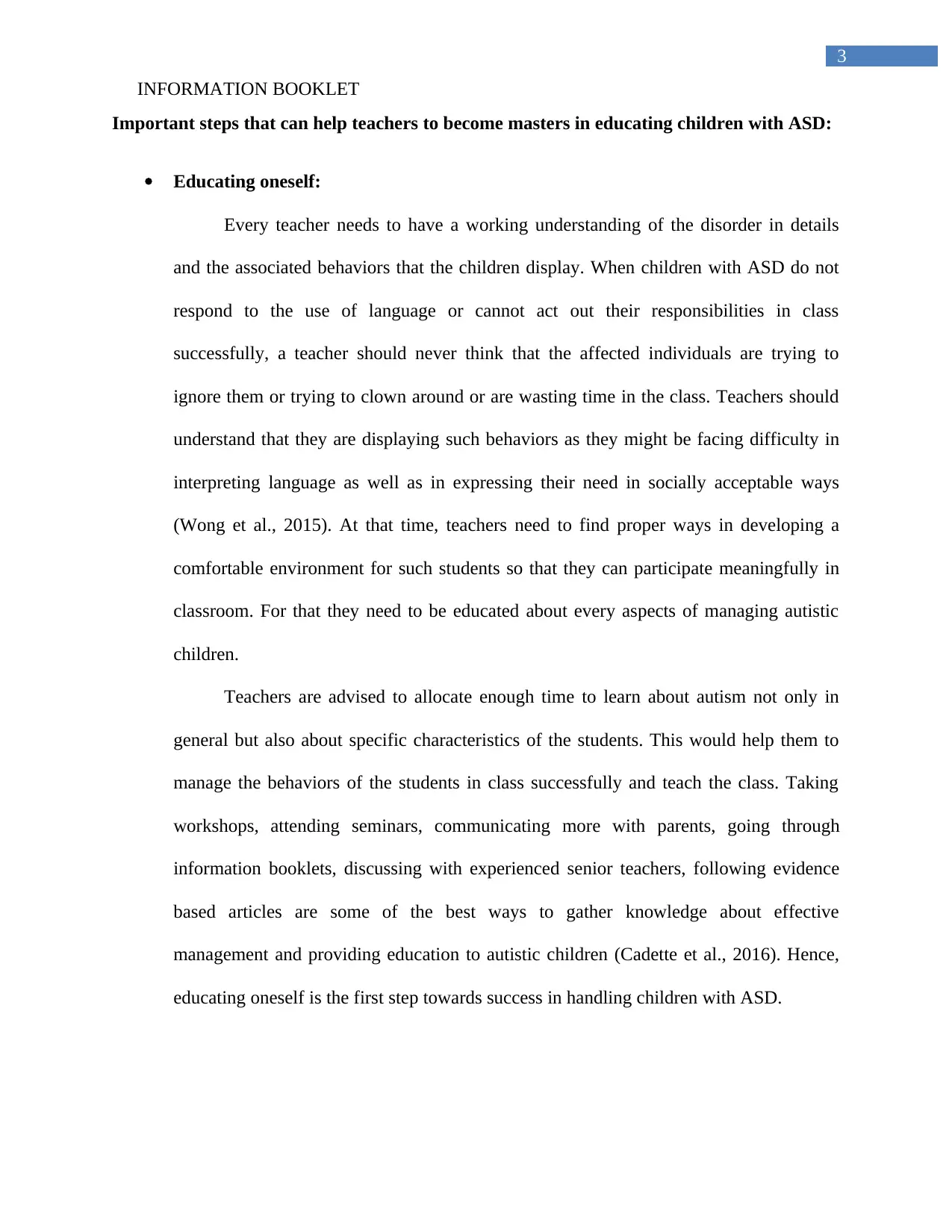
3
INFORMATION BOOKLET
Important steps that can help teachers to become masters in educating children with ASD:
Educating oneself:
Every teacher needs to have a working understanding of the disorder in details
and the associated behaviors that the children display. When children with ASD do not
respond to the use of language or cannot act out their responsibilities in class
successfully, a teacher should never think that the affected individuals are trying to
ignore them or trying to clown around or are wasting time in the class. Teachers should
understand that they are displaying such behaviors as they might be facing difficulty in
interpreting language as well as in expressing their need in socially acceptable ways
(Wong et al., 2015). At that time, teachers need to find proper ways in developing a
comfortable environment for such students so that they can participate meaningfully in
classroom. For that they need to be educated about every aspects of managing autistic
children.
Teachers are advised to allocate enough time to learn about autism not only in
general but also about specific characteristics of the students. This would help them to
manage the behaviors of the students in class successfully and teach the class. Taking
workshops, attending seminars, communicating more with parents, going through
information booklets, discussing with experienced senior teachers, following evidence
based articles are some of the best ways to gather knowledge about effective
management and providing education to autistic children (Cadette et al., 2016). Hence,
educating oneself is the first step towards success in handling children with ASD.
INFORMATION BOOKLET
Important steps that can help teachers to become masters in educating children with ASD:
Educating oneself:
Every teacher needs to have a working understanding of the disorder in details
and the associated behaviors that the children display. When children with ASD do not
respond to the use of language or cannot act out their responsibilities in class
successfully, a teacher should never think that the affected individuals are trying to
ignore them or trying to clown around or are wasting time in the class. Teachers should
understand that they are displaying such behaviors as they might be facing difficulty in
interpreting language as well as in expressing their need in socially acceptable ways
(Wong et al., 2015). At that time, teachers need to find proper ways in developing a
comfortable environment for such students so that they can participate meaningfully in
classroom. For that they need to be educated about every aspects of managing autistic
children.
Teachers are advised to allocate enough time to learn about autism not only in
general but also about specific characteristics of the students. This would help them to
manage the behaviors of the students in class successfully and teach the class. Taking
workshops, attending seminars, communicating more with parents, going through
information booklets, discussing with experienced senior teachers, following evidence
based articles are some of the best ways to gather knowledge about effective
management and providing education to autistic children (Cadette et al., 2016). Hence,
educating oneself is the first step towards success in handling children with ASD.
Secure Best Marks with AI Grader
Need help grading? Try our AI Grader for instant feedback on your assignments.
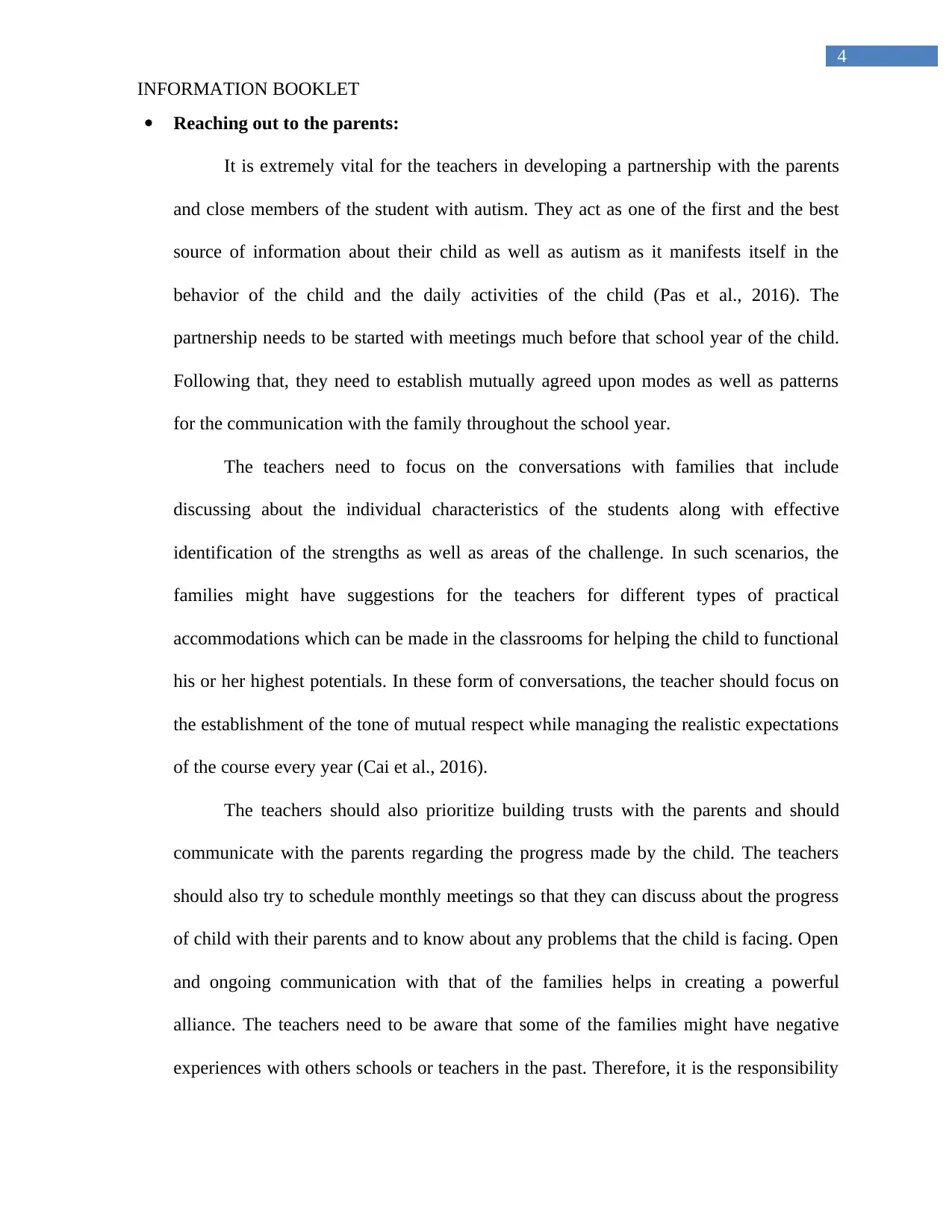
4
INFORMATION BOOKLET
Reaching out to the parents:
It is extremely vital for the teachers in developing a partnership with the parents
and close members of the student with autism. They act as one of the first and the best
source of information about their child as well as autism as it manifests itself in the
behavior of the child and the daily activities of the child (Pas et al., 2016). The
partnership needs to be started with meetings much before that school year of the child.
Following that, they need to establish mutually agreed upon modes as well as patterns
for the communication with the family throughout the school year.
The teachers need to focus on the conversations with families that include
discussing about the individual characteristics of the students along with effective
identification of the strengths as well as areas of the challenge. In such scenarios, the
families might have suggestions for the teachers for different types of practical
accommodations which can be made in the classrooms for helping the child to functional
his or her highest potentials. In these form of conversations, the teacher should focus on
the establishment of the tone of mutual respect while managing the realistic expectations
of the course every year (Cai et al., 2016).
The teachers should also prioritize building trusts with the parents and should
communicate with the parents regarding the progress made by the child. The teachers
should also try to schedule monthly meetings so that they can discuss about the progress
of child with their parents and to know about any problems that the child is facing. Open
and ongoing communication with that of the families helps in creating a powerful
alliance. The teachers need to be aware that some of the families might have negative
experiences with others schools or teachers in the past. Therefore, it is the responsibility
INFORMATION BOOKLET
Reaching out to the parents:
It is extremely vital for the teachers in developing a partnership with the parents
and close members of the student with autism. They act as one of the first and the best
source of information about their child as well as autism as it manifests itself in the
behavior of the child and the daily activities of the child (Pas et al., 2016). The
partnership needs to be started with meetings much before that school year of the child.
Following that, they need to establish mutually agreed upon modes as well as patterns
for the communication with the family throughout the school year.
The teachers need to focus on the conversations with families that include
discussing about the individual characteristics of the students along with effective
identification of the strengths as well as areas of the challenge. In such scenarios, the
families might have suggestions for the teachers for different types of practical
accommodations which can be made in the classrooms for helping the child to functional
his or her highest potentials. In these form of conversations, the teacher should focus on
the establishment of the tone of mutual respect while managing the realistic expectations
of the course every year (Cai et al., 2016).
The teachers should also prioritize building trusts with the parents and should
communicate with the parents regarding the progress made by the child. The teachers
should also try to schedule monthly meetings so that they can discuss about the progress
of child with their parents and to know about any problems that the child is facing. Open
and ongoing communication with that of the families helps in creating a powerful
alliance. The teachers need to be aware that some of the families might have negative
experiences with others schools or teachers in the past. Therefore, it is the responsibility
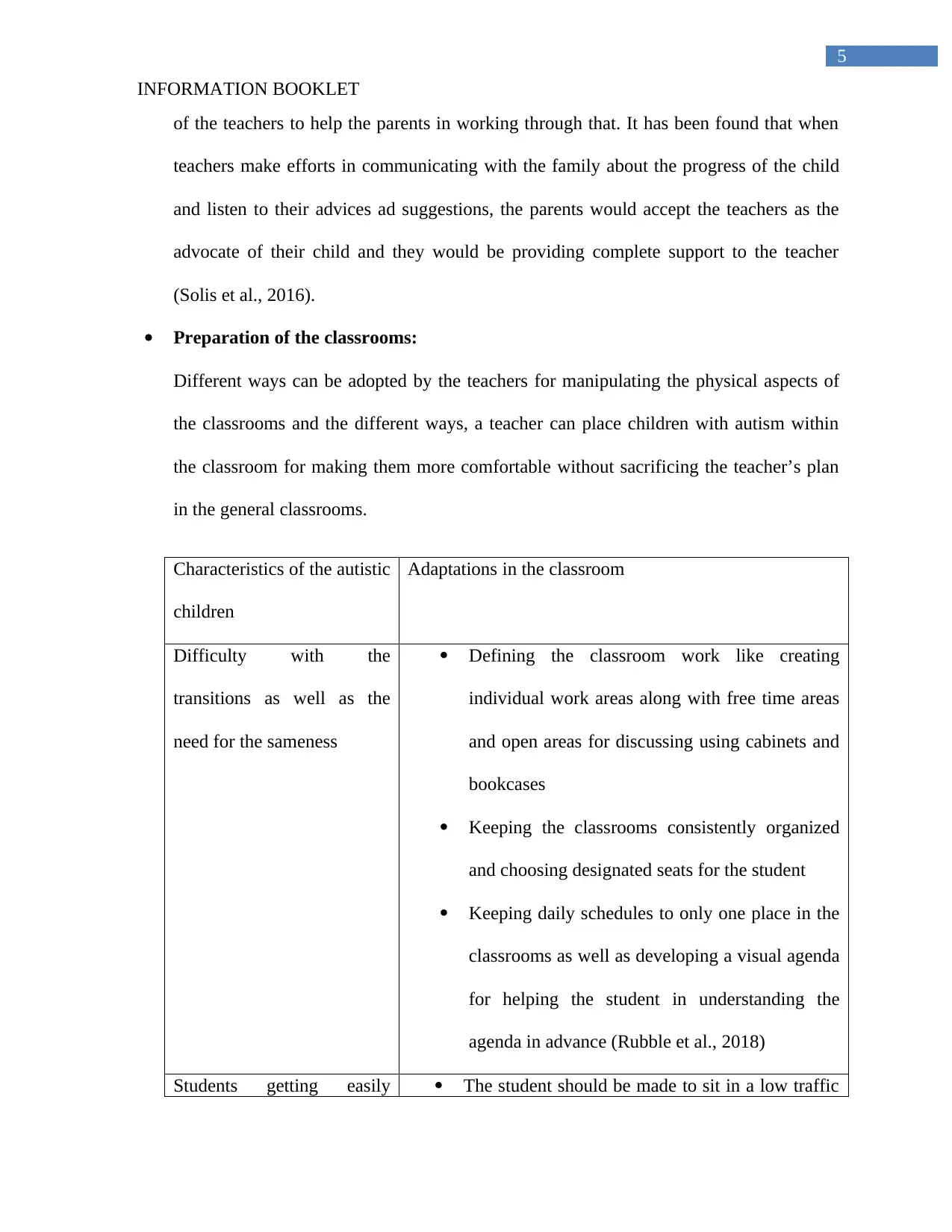
5
INFORMATION BOOKLET
of the teachers to help the parents in working through that. It has been found that when
teachers make efforts in communicating with the family about the progress of the child
and listen to their advices ad suggestions, the parents would accept the teachers as the
advocate of their child and they would be providing complete support to the teacher
(Solis et al., 2016).
Preparation of the classrooms:
Different ways can be adopted by the teachers for manipulating the physical aspects of
the classrooms and the different ways, a teacher can place children with autism within
the classroom for making them more comfortable without sacrificing the teacher’s plan
in the general classrooms.
Characteristics of the autistic
children
Adaptations in the classroom
Difficulty with the
transitions as well as the
need for the sameness
Defining the classroom work like creating
individual work areas along with free time areas
and open areas for discussing using cabinets and
bookcases
Keeping the classrooms consistently organized
and choosing designated seats for the student
Keeping daily schedules to only one place in the
classrooms as well as developing a visual agenda
for helping the student in understanding the
agenda in advance (Rubble et al., 2018)
Students getting easily The student should be made to sit in a low traffic
INFORMATION BOOKLET
of the teachers to help the parents in working through that. It has been found that when
teachers make efforts in communicating with the family about the progress of the child
and listen to their advices ad suggestions, the parents would accept the teachers as the
advocate of their child and they would be providing complete support to the teacher
(Solis et al., 2016).
Preparation of the classrooms:
Different ways can be adopted by the teachers for manipulating the physical aspects of
the classrooms and the different ways, a teacher can place children with autism within
the classroom for making them more comfortable without sacrificing the teacher’s plan
in the general classrooms.
Characteristics of the autistic
children
Adaptations in the classroom
Difficulty with the
transitions as well as the
need for the sameness
Defining the classroom work like creating
individual work areas along with free time areas
and open areas for discussing using cabinets and
bookcases
Keeping the classrooms consistently organized
and choosing designated seats for the student
Keeping daily schedules to only one place in the
classrooms as well as developing a visual agenda
for helping the student in understanding the
agenda in advance (Rubble et al., 2018)
Students getting easily The student should be made to sit in a low traffic
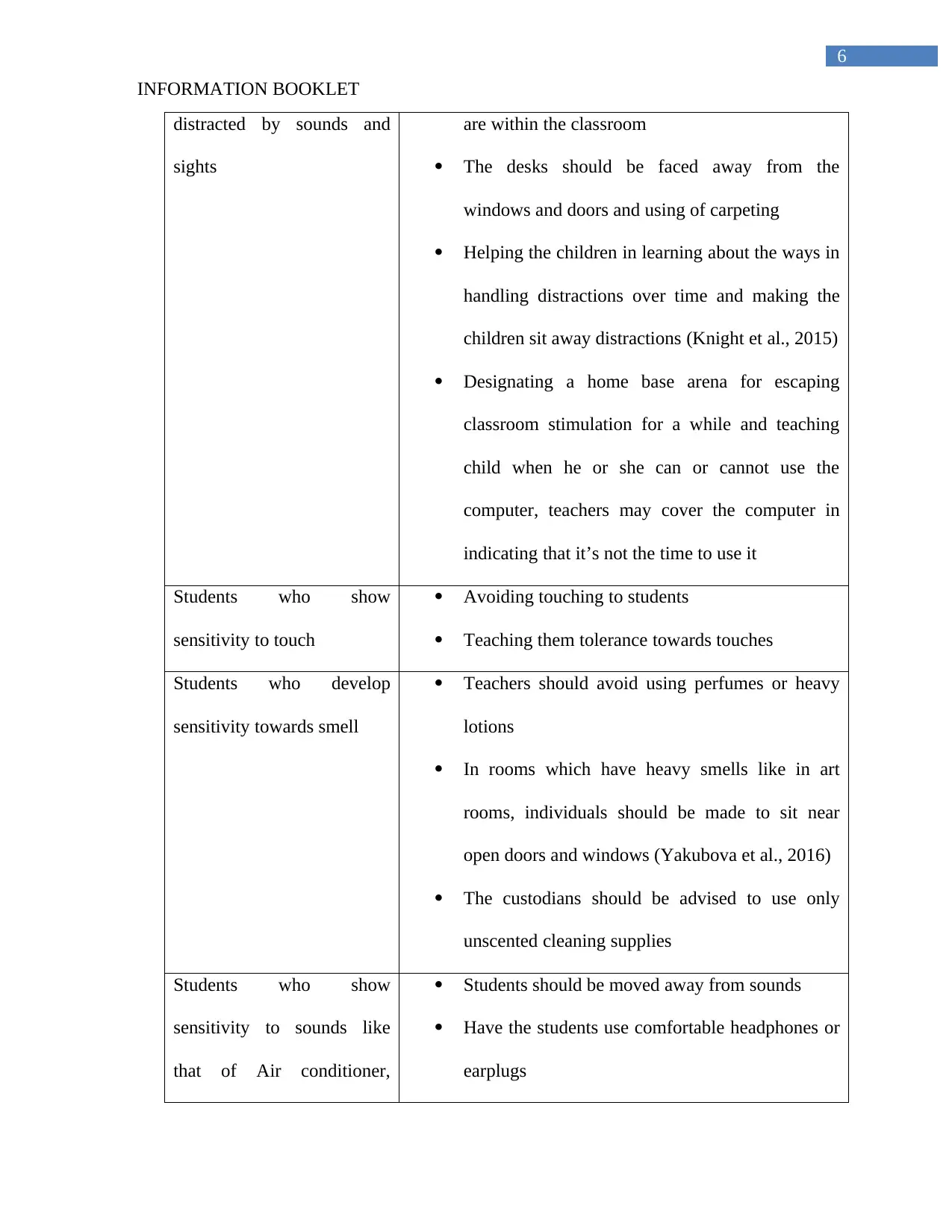
6
INFORMATION BOOKLET
distracted by sounds and
sights
are within the classroom
The desks should be faced away from the
windows and doors and using of carpeting
Helping the children in learning about the ways in
handling distractions over time and making the
children sit away distractions (Knight et al., 2015)
Designating a home base arena for escaping
classroom stimulation for a while and teaching
child when he or she can or cannot use the
computer, teachers may cover the computer in
indicating that it’s not the time to use it
Students who show
sensitivity to touch
Avoiding touching to students
Teaching them tolerance towards touches
Students who develop
sensitivity towards smell
Teachers should avoid using perfumes or heavy
lotions
In rooms which have heavy smells like in art
rooms, individuals should be made to sit near
open doors and windows (Yakubova et al., 2016)
The custodians should be advised to use only
unscented cleaning supplies
Students who show
sensitivity to sounds like
that of Air conditioner,
Students should be moved away from sounds
Have the students use comfortable headphones or
earplugs
INFORMATION BOOKLET
distracted by sounds and
sights
are within the classroom
The desks should be faced away from the
windows and doors and using of carpeting
Helping the children in learning about the ways in
handling distractions over time and making the
children sit away distractions (Knight et al., 2015)
Designating a home base arena for escaping
classroom stimulation for a while and teaching
child when he or she can or cannot use the
computer, teachers may cover the computer in
indicating that it’s not the time to use it
Students who show
sensitivity to touch
Avoiding touching to students
Teaching them tolerance towards touches
Students who develop
sensitivity towards smell
Teachers should avoid using perfumes or heavy
lotions
In rooms which have heavy smells like in art
rooms, individuals should be made to sit near
open doors and windows (Yakubova et al., 2016)
The custodians should be advised to use only
unscented cleaning supplies
Students who show
sensitivity to sounds like
that of Air conditioner,
Students should be moved away from sounds
Have the students use comfortable headphones or
earplugs
Paraphrase This Document
Need a fresh take? Get an instant paraphrase of this document with our AI Paraphraser

7
INFORMATION BOOKLET
scratching of pencils,
shuffling of feet, certain
tones of music
Using soft voices when possible
Materials should be put under desk legs and
carpets and carpeting remnants should be installed
Students should be gradually taught tolerance to
students and prepare them for sounds before they
need to learn fire drill or ringing of bells.
Students who show
sensitivity to light that like
the fluorescent light
The teacher should lower the level of light and
turn off overhead lights
Trying different colors of lights and having
students use sunglasses or that like the baseball
cap (Syriopoulou-Delli et al., 2019)
Moving the seats of the students from reflections
on that of the wall and using the bulbs that do not
flicker.
Students showing
problematic or acting out
behaviors
If the escape is the function, then the teacher
should not allow the child to escape without
having accomplished something first or the
teacher might also express importance to
communicate appropriately the need for some
self-down time. The teachers should preferable
use a break area before blowing up (Diener et al.,
2016).
Having the recreation area as well as the
INFORMATION BOOKLET
scratching of pencils,
shuffling of feet, certain
tones of music
Using soft voices when possible
Materials should be put under desk legs and
carpets and carpeting remnants should be installed
Students should be gradually taught tolerance to
students and prepare them for sounds before they
need to learn fire drill or ringing of bells.
Students who show
sensitivity to light that like
the fluorescent light
The teacher should lower the level of light and
turn off overhead lights
Trying different colors of lights and having
students use sunglasses or that like the baseball
cap (Syriopoulou-Delli et al., 2019)
Moving the seats of the students from reflections
on that of the wall and using the bulbs that do not
flicker.
Students showing
problematic or acting out
behaviors
If the escape is the function, then the teacher
should not allow the child to escape without
having accomplished something first or the
teacher might also express importance to
communicate appropriately the need for some
self-down time. The teachers should preferable
use a break area before blowing up (Diener et al.,
2016).
Having the recreation area as well as the
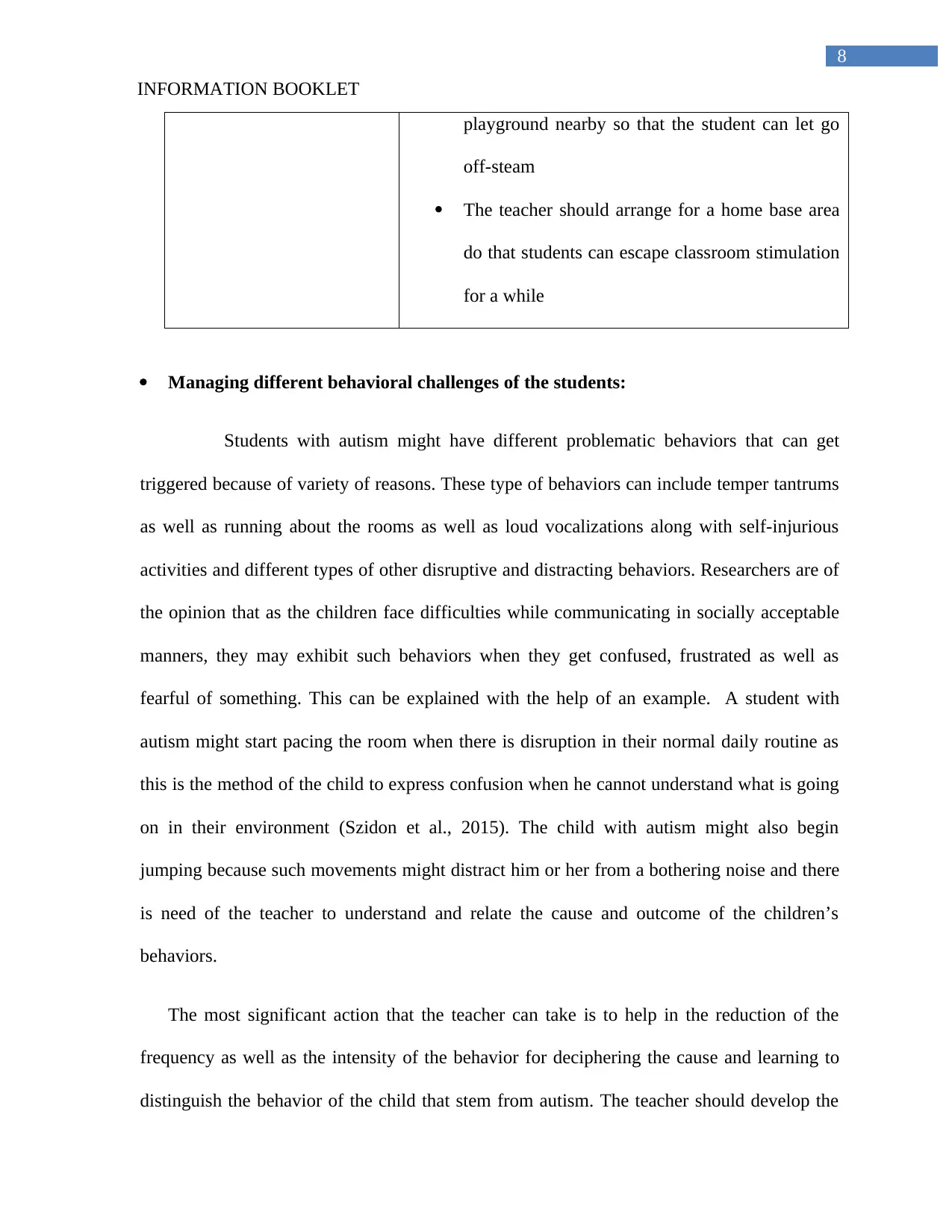
8
INFORMATION BOOKLET
playground nearby so that the student can let go
off-steam
The teacher should arrange for a home base area
do that students can escape classroom stimulation
for a while
Managing different behavioral challenges of the students:
Students with autism might have different problematic behaviors that can get
triggered because of variety of reasons. These type of behaviors can include temper tantrums
as well as running about the rooms as well as loud vocalizations along with self-injurious
activities and different types of other disruptive and distracting behaviors. Researchers are of
the opinion that as the children face difficulties while communicating in socially acceptable
manners, they may exhibit such behaviors when they get confused, frustrated as well as
fearful of something. This can be explained with the help of an example. A student with
autism might start pacing the room when there is disruption in their normal daily routine as
this is the method of the child to express confusion when he cannot understand what is going
on in their environment (Szidon et al., 2015). The child with autism might also begin
jumping because such movements might distract him or her from a bothering noise and there
is need of the teacher to understand and relate the cause and outcome of the children’s
behaviors.
The most significant action that the teacher can take is to help in the reduction of the
frequency as well as the intensity of the behavior for deciphering the cause and learning to
distinguish the behavior of the child that stem from autism. The teacher should develop the
INFORMATION BOOKLET
playground nearby so that the student can let go
off-steam
The teacher should arrange for a home base area
do that students can escape classroom stimulation
for a while
Managing different behavioral challenges of the students:
Students with autism might have different problematic behaviors that can get
triggered because of variety of reasons. These type of behaviors can include temper tantrums
as well as running about the rooms as well as loud vocalizations along with self-injurious
activities and different types of other disruptive and distracting behaviors. Researchers are of
the opinion that as the children face difficulties while communicating in socially acceptable
manners, they may exhibit such behaviors when they get confused, frustrated as well as
fearful of something. This can be explained with the help of an example. A student with
autism might start pacing the room when there is disruption in their normal daily routine as
this is the method of the child to express confusion when he cannot understand what is going
on in their environment (Szidon et al., 2015). The child with autism might also begin
jumping because such movements might distract him or her from a bothering noise and there
is need of the teacher to understand and relate the cause and outcome of the children’s
behaviors.
The most significant action that the teacher can take is to help in the reduction of the
frequency as well as the intensity of the behavior for deciphering the cause and learning to
distinguish the behavior of the child that stem from autism. The teacher should develop the
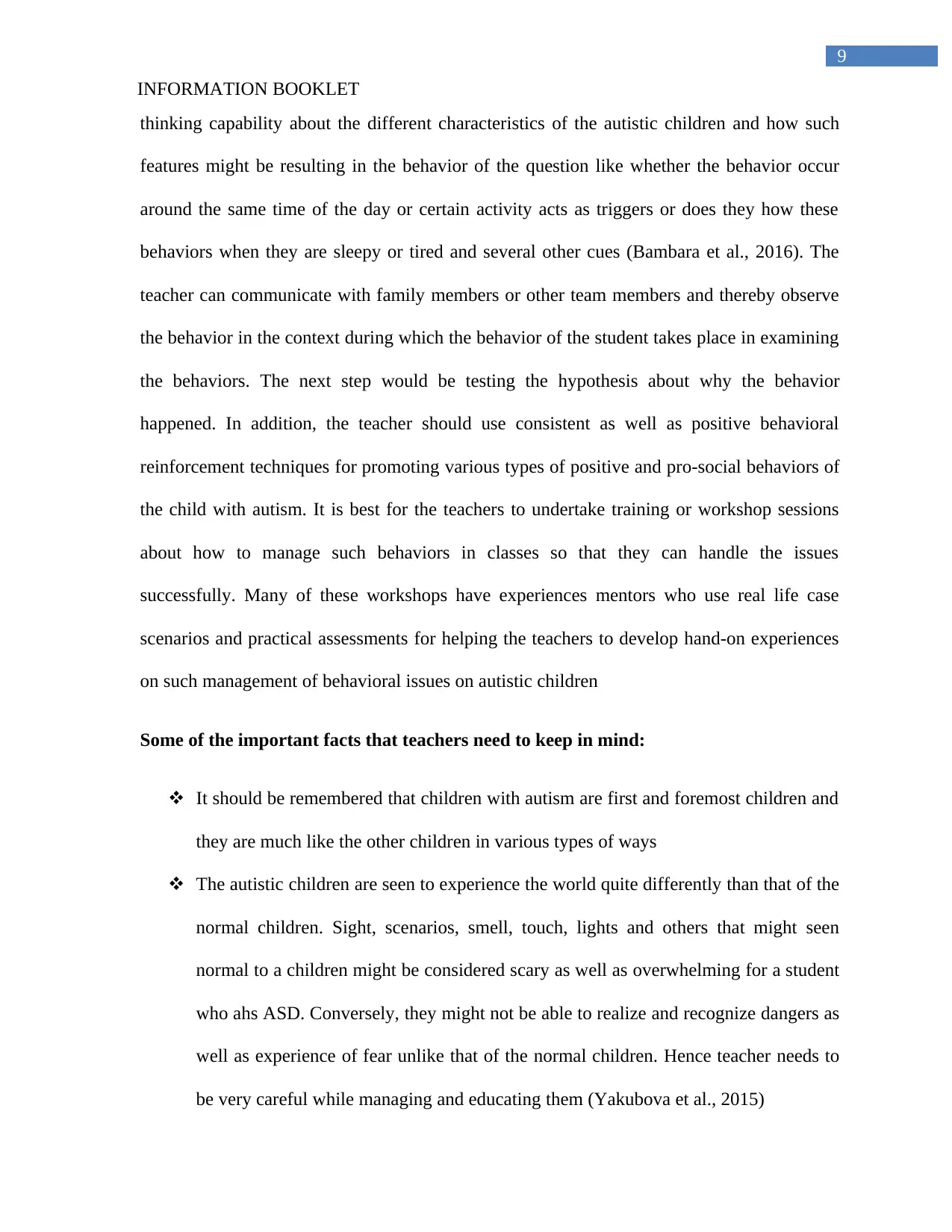
9
INFORMATION BOOKLET
thinking capability about the different characteristics of the autistic children and how such
features might be resulting in the behavior of the question like whether the behavior occur
around the same time of the day or certain activity acts as triggers or does they how these
behaviors when they are sleepy or tired and several other cues (Bambara et al., 2016). The
teacher can communicate with family members or other team members and thereby observe
the behavior in the context during which the behavior of the student takes place in examining
the behaviors. The next step would be testing the hypothesis about why the behavior
happened. In addition, the teacher should use consistent as well as positive behavioral
reinforcement techniques for promoting various types of positive and pro-social behaviors of
the child with autism. It is best for the teachers to undertake training or workshop sessions
about how to manage such behaviors in classes so that they can handle the issues
successfully. Many of these workshops have experiences mentors who use real life case
scenarios and practical assessments for helping the teachers to develop hand-on experiences
on such management of behavioral issues on autistic children
Some of the important facts that teachers need to keep in mind:
It should be remembered that children with autism are first and foremost children and
they are much like the other children in various types of ways
The autistic children are seen to experience the world quite differently than that of the
normal children. Sight, scenarios, smell, touch, lights and others that might seen
normal to a children might be considered scary as well as overwhelming for a student
who ahs ASD. Conversely, they might not be able to realize and recognize dangers as
well as experience of fear unlike that of the normal children. Hence teacher needs to
be very careful while managing and educating them (Yakubova et al., 2015)
INFORMATION BOOKLET
thinking capability about the different characteristics of the autistic children and how such
features might be resulting in the behavior of the question like whether the behavior occur
around the same time of the day or certain activity acts as triggers or does they how these
behaviors when they are sleepy or tired and several other cues (Bambara et al., 2016). The
teacher can communicate with family members or other team members and thereby observe
the behavior in the context during which the behavior of the student takes place in examining
the behaviors. The next step would be testing the hypothesis about why the behavior
happened. In addition, the teacher should use consistent as well as positive behavioral
reinforcement techniques for promoting various types of positive and pro-social behaviors of
the child with autism. It is best for the teachers to undertake training or workshop sessions
about how to manage such behaviors in classes so that they can handle the issues
successfully. Many of these workshops have experiences mentors who use real life case
scenarios and practical assessments for helping the teachers to develop hand-on experiences
on such management of behavioral issues on autistic children
Some of the important facts that teachers need to keep in mind:
It should be remembered that children with autism are first and foremost children and
they are much like the other children in various types of ways
The autistic children are seen to experience the world quite differently than that of the
normal children. Sight, scenarios, smell, touch, lights and others that might seen
normal to a children might be considered scary as well as overwhelming for a student
who ahs ASD. Conversely, they might not be able to realize and recognize dangers as
well as experience of fear unlike that of the normal children. Hence teacher needs to
be very careful while managing and educating them (Yakubova et al., 2015)
Secure Best Marks with AI Grader
Need help grading? Try our AI Grader for instant feedback on your assignments.
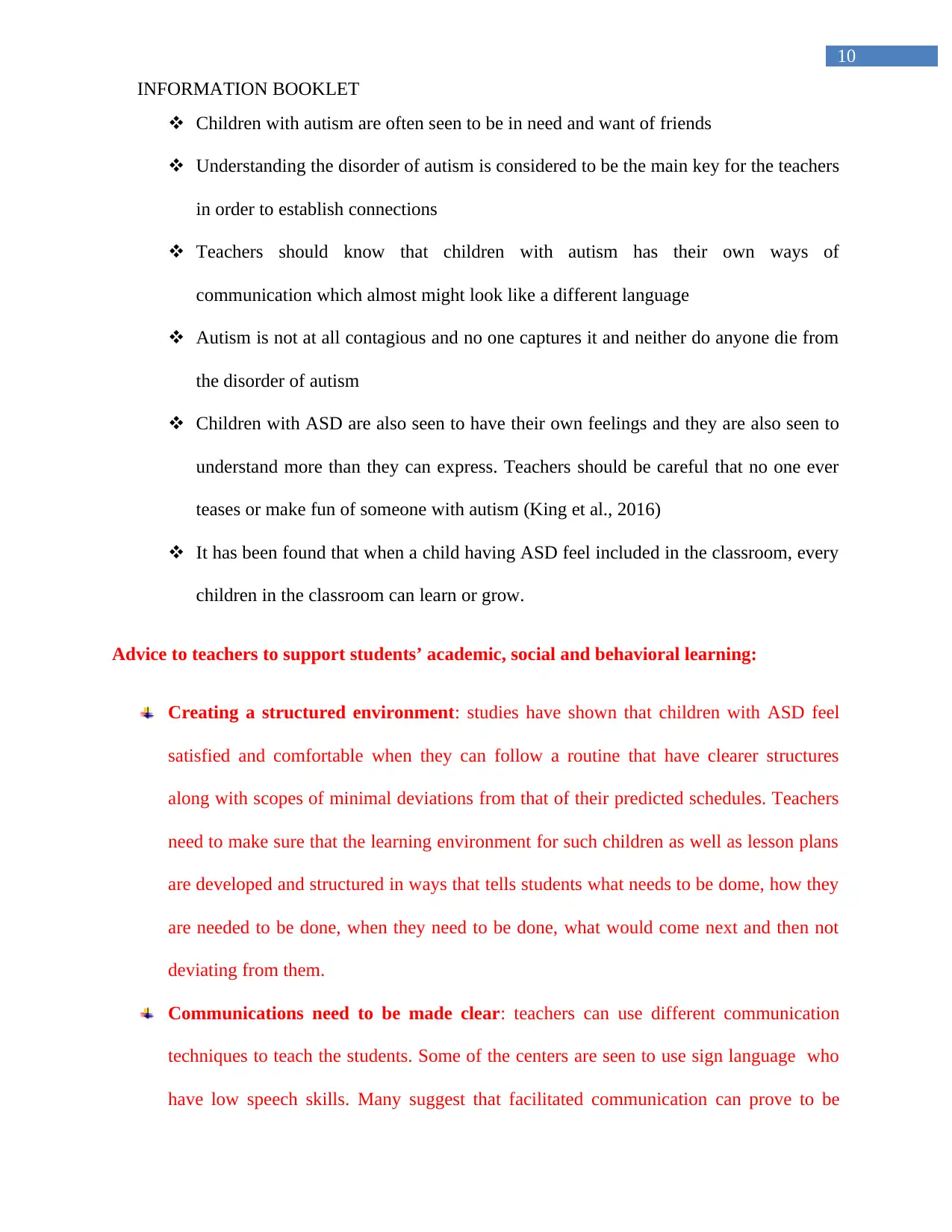
10
INFORMATION BOOKLET
Children with autism are often seen to be in need and want of friends
Understanding the disorder of autism is considered to be the main key for the teachers
in order to establish connections
Teachers should know that children with autism has their own ways of
communication which almost might look like a different language
Autism is not at all contagious and no one captures it and neither do anyone die from
the disorder of autism
Children with ASD are also seen to have their own feelings and they are also seen to
understand more than they can express. Teachers should be careful that no one ever
teases or make fun of someone with autism (King et al., 2016)
It has been found that when a child having ASD feel included in the classroom, every
children in the classroom can learn or grow.
Advice to teachers to support students’ academic, social and behavioral learning:
Creating a structured environment: studies have shown that children with ASD feel
satisfied and comfortable when they can follow a routine that have clearer structures
along with scopes of minimal deviations from that of their predicted schedules. Teachers
need to make sure that the learning environment for such children as well as lesson plans
are developed and structured in ways that tells students what needs to be dome, how they
are needed to be done, when they need to be done, what would come next and then not
deviating from them.
Communications need to be made clear: teachers can use different communication
techniques to teach the students. Some of the centers are seen to use sign language who
have low speech skills. Many suggest that facilitated communication can prove to be
INFORMATION BOOKLET
Children with autism are often seen to be in need and want of friends
Understanding the disorder of autism is considered to be the main key for the teachers
in order to establish connections
Teachers should know that children with autism has their own ways of
communication which almost might look like a different language
Autism is not at all contagious and no one captures it and neither do anyone die from
the disorder of autism
Children with ASD are also seen to have their own feelings and they are also seen to
understand more than they can express. Teachers should be careful that no one ever
teases or make fun of someone with autism (King et al., 2016)
It has been found that when a child having ASD feel included in the classroom, every
children in the classroom can learn or grow.
Advice to teachers to support students’ academic, social and behavioral learning:
Creating a structured environment: studies have shown that children with ASD feel
satisfied and comfortable when they can follow a routine that have clearer structures
along with scopes of minimal deviations from that of their predicted schedules. Teachers
need to make sure that the learning environment for such children as well as lesson plans
are developed and structured in ways that tells students what needs to be dome, how they
are needed to be done, when they need to be done, what would come next and then not
deviating from them.
Communications need to be made clear: teachers can use different communication
techniques to teach the students. Some of the centers are seen to use sign language who
have low speech skills. Many suggest that facilitated communication can prove to be
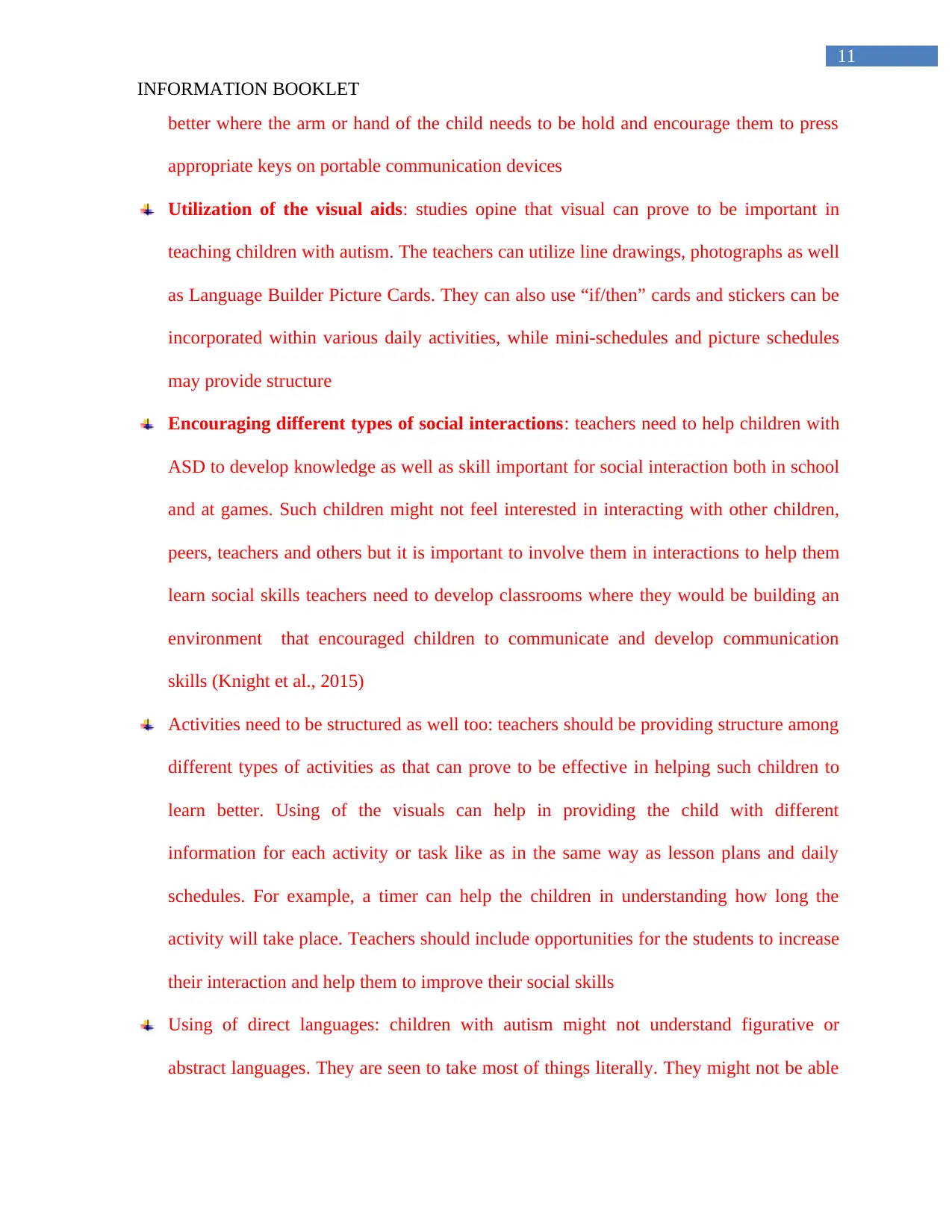
11
INFORMATION BOOKLET
better where the arm or hand of the child needs to be hold and encourage them to press
appropriate keys on portable communication devices
Utilization of the visual aids: studies opine that visual can prove to be important in
teaching children with autism. The teachers can utilize line drawings, photographs as well
as Language Builder Picture Cards. They can also use “if/then” cards and stickers can be
incorporated within various daily activities, while mini-schedules and picture schedules
may provide structure
Encouraging different types of social interactions: teachers need to help children with
ASD to develop knowledge as well as skill important for social interaction both in school
and at games. Such children might not feel interested in interacting with other children,
peers, teachers and others but it is important to involve them in interactions to help them
learn social skills teachers need to develop classrooms where they would be building an
environment that encouraged children to communicate and develop communication
skills (Knight et al., 2015)
Activities need to be structured as well too: teachers should be providing structure among
different types of activities as that can prove to be effective in helping such children to
learn better. Using of the visuals can help in providing the child with different
information for each activity or task like as in the same way as lesson plans and daily
schedules. For example, a timer can help the children in understanding how long the
activity will take place. Teachers should include opportunities for the students to increase
their interaction and help them to improve their social skills
Using of direct languages: children with autism might not understand figurative or
abstract languages. They are seen to take most of things literally. They might not be able
INFORMATION BOOKLET
better where the arm or hand of the child needs to be hold and encourage them to press
appropriate keys on portable communication devices
Utilization of the visual aids: studies opine that visual can prove to be important in
teaching children with autism. The teachers can utilize line drawings, photographs as well
as Language Builder Picture Cards. They can also use “if/then” cards and stickers can be
incorporated within various daily activities, while mini-schedules and picture schedules
may provide structure
Encouraging different types of social interactions: teachers need to help children with
ASD to develop knowledge as well as skill important for social interaction both in school
and at games. Such children might not feel interested in interacting with other children,
peers, teachers and others but it is important to involve them in interactions to help them
learn social skills teachers need to develop classrooms where they would be building an
environment that encouraged children to communicate and develop communication
skills (Knight et al., 2015)
Activities need to be structured as well too: teachers should be providing structure among
different types of activities as that can prove to be effective in helping such children to
learn better. Using of the visuals can help in providing the child with different
information for each activity or task like as in the same way as lesson plans and daily
schedules. For example, a timer can help the children in understanding how long the
activity will take place. Teachers should include opportunities for the students to increase
their interaction and help them to improve their social skills
Using of direct languages: children with autism might not understand figurative or
abstract languages. They are seen to take most of things literally. They might not be able
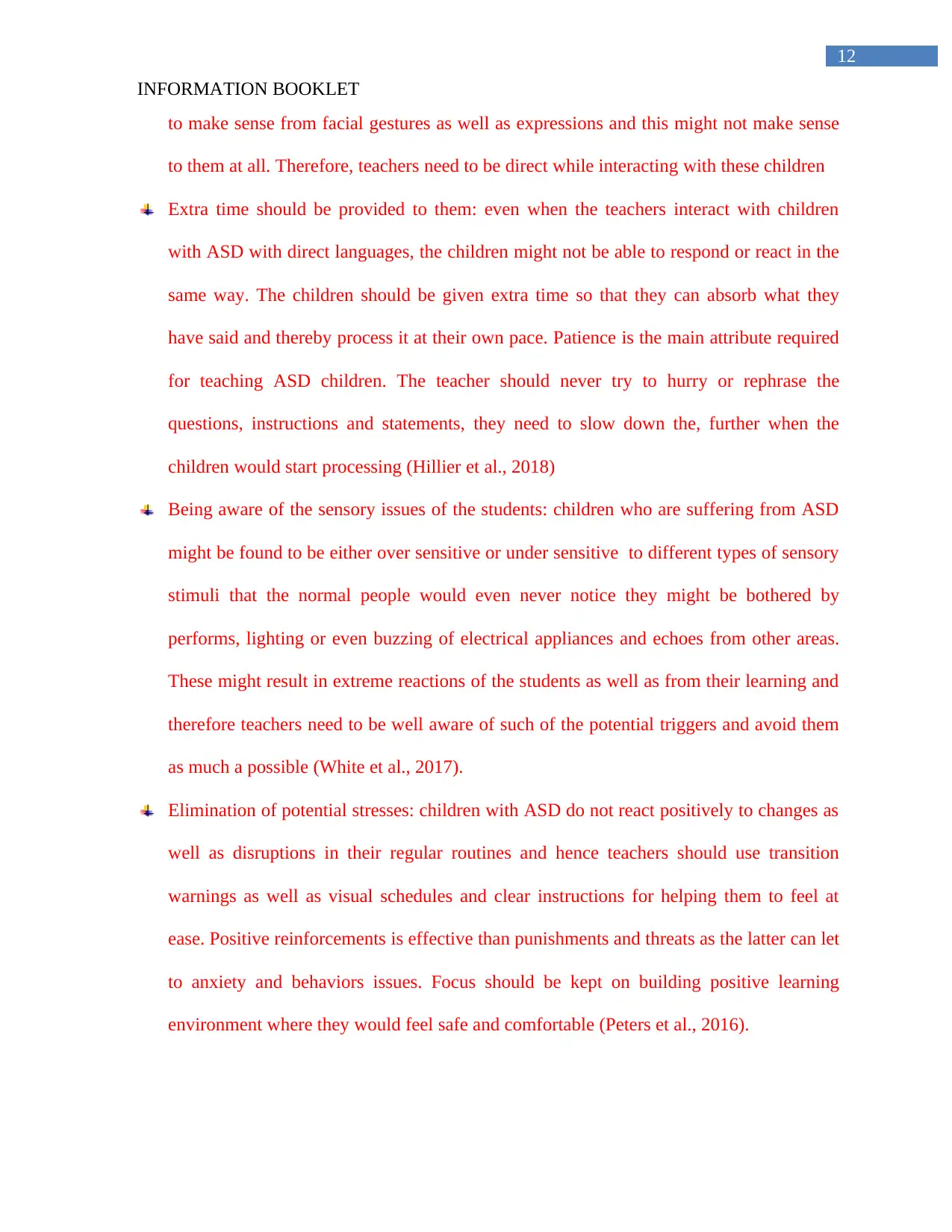
12
INFORMATION BOOKLET
to make sense from facial gestures as well as expressions and this might not make sense
to them at all. Therefore, teachers need to be direct while interacting with these children
Extra time should be provided to them: even when the teachers interact with children
with ASD with direct languages, the children might not be able to respond or react in the
same way. The children should be given extra time so that they can absorb what they
have said and thereby process it at their own pace. Patience is the main attribute required
for teaching ASD children. The teacher should never try to hurry or rephrase the
questions, instructions and statements, they need to slow down the, further when the
children would start processing (Hillier et al., 2018)
Being aware of the sensory issues of the students: children who are suffering from ASD
might be found to be either over sensitive or under sensitive to different types of sensory
stimuli that the normal people would even never notice they might be bothered by
performs, lighting or even buzzing of electrical appliances and echoes from other areas.
These might result in extreme reactions of the students as well as from their learning and
therefore teachers need to be well aware of such of the potential triggers and avoid them
as much a possible (White et al., 2017).
Elimination of potential stresses: children with ASD do not react positively to changes as
well as disruptions in their regular routines and hence teachers should use transition
warnings as well as visual schedules and clear instructions for helping them to feel at
ease. Positive reinforcements is effective than punishments and threats as the latter can let
to anxiety and behaviors issues. Focus should be kept on building positive learning
environment where they would feel safe and comfortable (Peters et al., 2016).
INFORMATION BOOKLET
to make sense from facial gestures as well as expressions and this might not make sense
to them at all. Therefore, teachers need to be direct while interacting with these children
Extra time should be provided to them: even when the teachers interact with children
with ASD with direct languages, the children might not be able to respond or react in the
same way. The children should be given extra time so that they can absorb what they
have said and thereby process it at their own pace. Patience is the main attribute required
for teaching ASD children. The teacher should never try to hurry or rephrase the
questions, instructions and statements, they need to slow down the, further when the
children would start processing (Hillier et al., 2018)
Being aware of the sensory issues of the students: children who are suffering from ASD
might be found to be either over sensitive or under sensitive to different types of sensory
stimuli that the normal people would even never notice they might be bothered by
performs, lighting or even buzzing of electrical appliances and echoes from other areas.
These might result in extreme reactions of the students as well as from their learning and
therefore teachers need to be well aware of such of the potential triggers and avoid them
as much a possible (White et al., 2017).
Elimination of potential stresses: children with ASD do not react positively to changes as
well as disruptions in their regular routines and hence teachers should use transition
warnings as well as visual schedules and clear instructions for helping them to feel at
ease. Positive reinforcements is effective than punishments and threats as the latter can let
to anxiety and behaviors issues. Focus should be kept on building positive learning
environment where they would feel safe and comfortable (Peters et al., 2016).
Paraphrase This Document
Need a fresh take? Get an instant paraphrase of this document with our AI Paraphraser
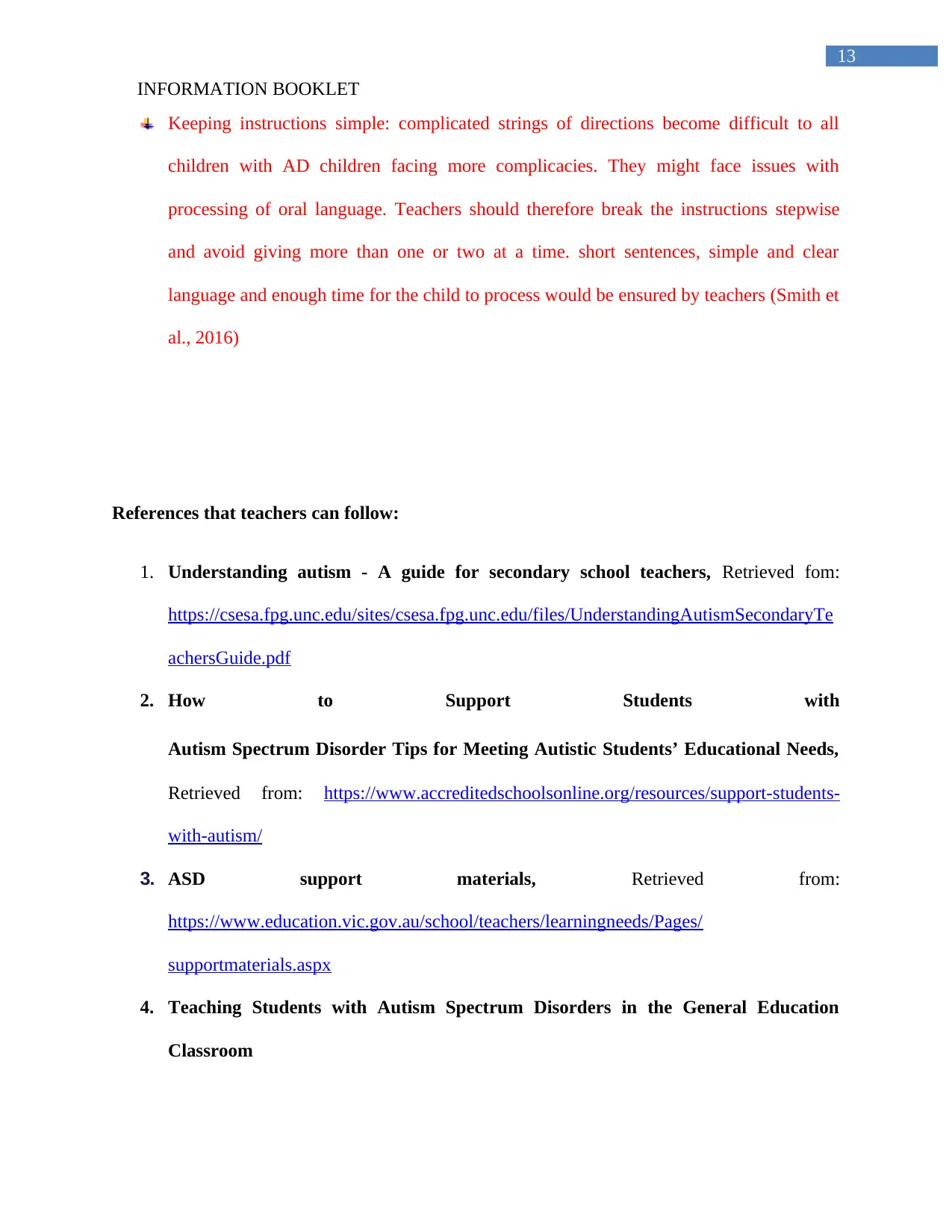
13
INFORMATION BOOKLET
Keeping instructions simple: complicated strings of directions become difficult to all
children with AD children facing more complicacies. They might face issues with
processing of oral language. Teachers should therefore break the instructions stepwise
and avoid giving more than one or two at a time. short sentences, simple and clear
language and enough time for the child to process would be ensured by teachers (Smith et
al., 2016)
References that teachers can follow:
1. Understanding autism - A guide for secondary school teachers, Retrieved fom:
https://csesa.fpg.unc.edu/sites/csesa.fpg.unc.edu/files/UnderstandingAutismSecondaryTe
achersGuide.pdf
2. How to Support Students with
Autism Spectrum Disorder Tips for Meeting Autistic Students’ Educational Needs,
Retrieved from: https://www.accreditedschoolsonline.org/resources/support-students-
with-autism/
3. ASD support materials, Retrieved from:
https://www.education.vic.gov.au/school/teachers/learningneeds/Pages/
supportmaterials.aspx
4. Teaching Students with Autism Spectrum Disorders in the General Education
Classroom
INFORMATION BOOKLET
Keeping instructions simple: complicated strings of directions become difficult to all
children with AD children facing more complicacies. They might face issues with
processing of oral language. Teachers should therefore break the instructions stepwise
and avoid giving more than one or two at a time. short sentences, simple and clear
language and enough time for the child to process would be ensured by teachers (Smith et
al., 2016)
References that teachers can follow:
1. Understanding autism - A guide for secondary school teachers, Retrieved fom:
https://csesa.fpg.unc.edu/sites/csesa.fpg.unc.edu/files/UnderstandingAutismSecondaryTe
achersGuide.pdf
2. How to Support Students with
Autism Spectrum Disorder Tips for Meeting Autistic Students’ Educational Needs,
Retrieved from: https://www.accreditedschoolsonline.org/resources/support-students-
with-autism/
3. ASD support materials, Retrieved from:
https://www.education.vic.gov.au/school/teachers/learningneeds/Pages/
supportmaterials.aspx
4. Teaching Students with Autism Spectrum Disorders in the General Education
Classroom
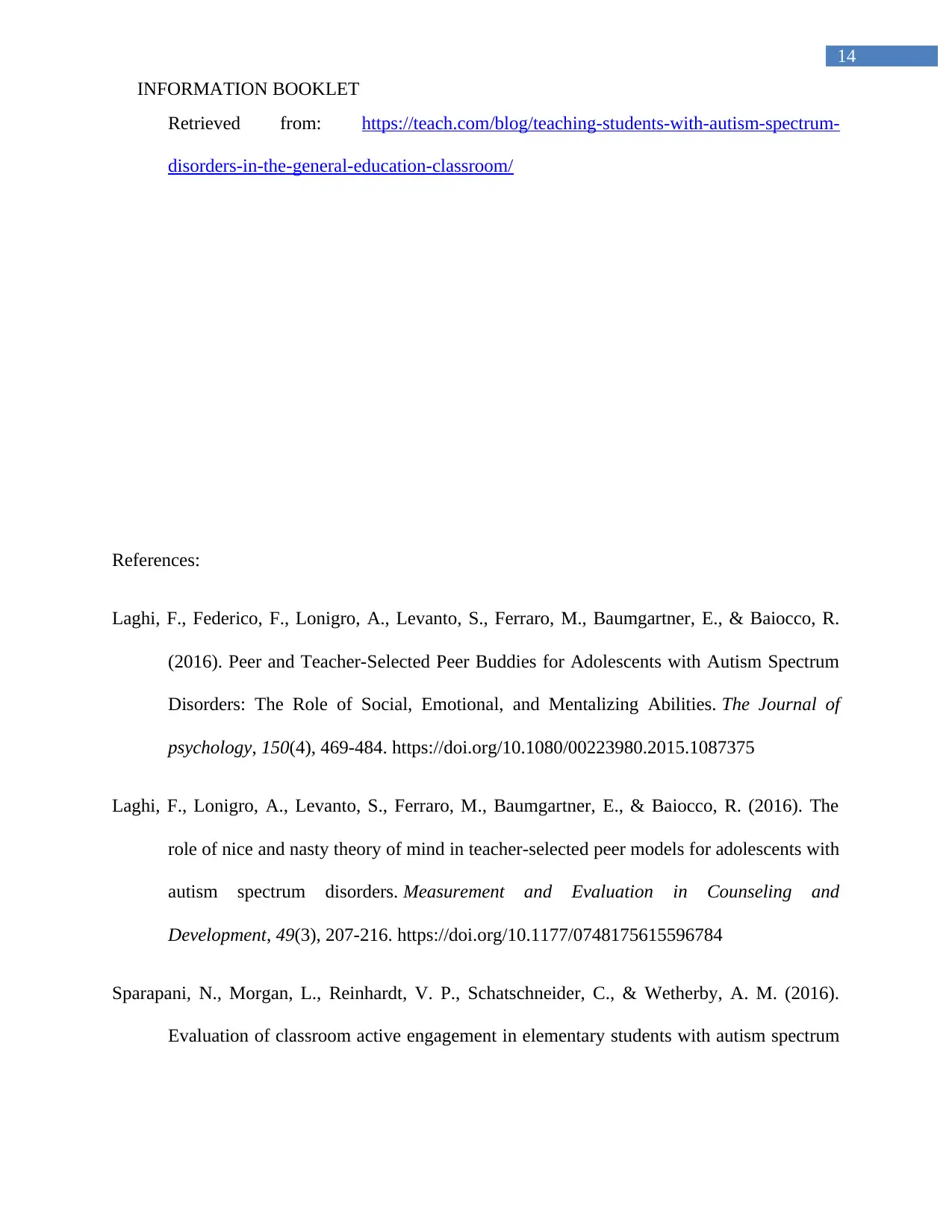
14
INFORMATION BOOKLET
Retrieved from: https://teach.com/blog/teaching-students-with-autism-spectrum-
disorders-in-the-general-education-classroom/
References:
Laghi, F., Federico, F., Lonigro, A., Levanto, S., Ferraro, M., Baumgartner, E., & Baiocco, R.
(2016). Peer and Teacher-Selected Peer Buddies for Adolescents with Autism Spectrum
Disorders: The Role of Social, Emotional, and Mentalizing Abilities. The Journal of
psychology, 150(4), 469-484. https://doi.org/10.1080/00223980.2015.1087375
Laghi, F., Lonigro, A., Levanto, S., Ferraro, M., Baumgartner, E., & Baiocco, R. (2016). The
role of nice and nasty theory of mind in teacher-selected peer models for adolescents with
autism spectrum disorders. Measurement and Evaluation in Counseling and
Development, 49(3), 207-216. https://doi.org/10.1177/0748175615596784
Sparapani, N., Morgan, L., Reinhardt, V. P., Schatschneider, C., & Wetherby, A. M. (2016).
Evaluation of classroom active engagement in elementary students with autism spectrum
INFORMATION BOOKLET
Retrieved from: https://teach.com/blog/teaching-students-with-autism-spectrum-
disorders-in-the-general-education-classroom/
References:
Laghi, F., Federico, F., Lonigro, A., Levanto, S., Ferraro, M., Baumgartner, E., & Baiocco, R.
(2016). Peer and Teacher-Selected Peer Buddies for Adolescents with Autism Spectrum
Disorders: The Role of Social, Emotional, and Mentalizing Abilities. The Journal of
psychology, 150(4), 469-484. https://doi.org/10.1080/00223980.2015.1087375
Laghi, F., Lonigro, A., Levanto, S., Ferraro, M., Baumgartner, E., & Baiocco, R. (2016). The
role of nice and nasty theory of mind in teacher-selected peer models for adolescents with
autism spectrum disorders. Measurement and Evaluation in Counseling and
Development, 49(3), 207-216. https://doi.org/10.1177/0748175615596784
Sparapani, N., Morgan, L., Reinhardt, V. P., Schatschneider, C., & Wetherby, A. M. (2016).
Evaluation of classroom active engagement in elementary students with autism spectrum
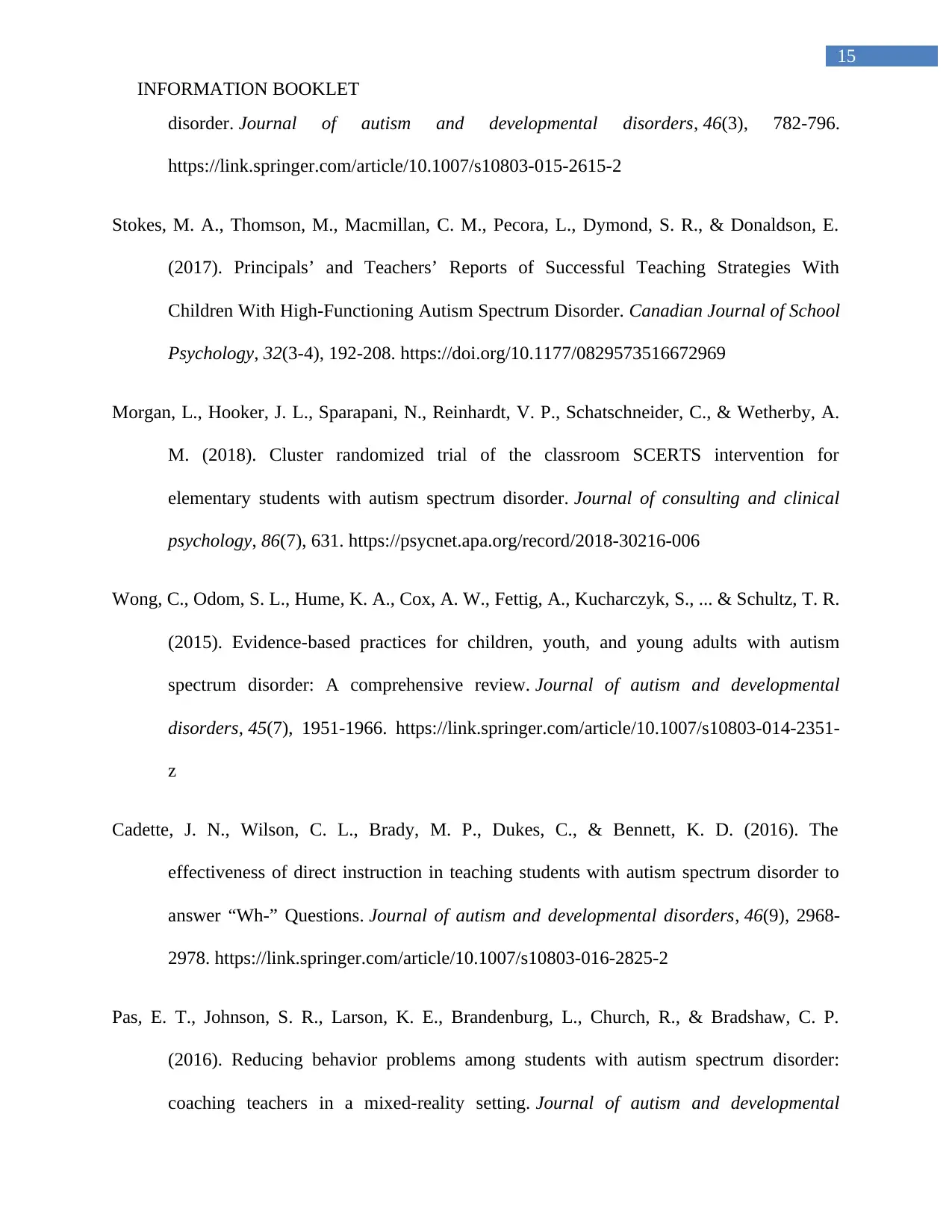
15
INFORMATION BOOKLET
disorder. Journal of autism and developmental disorders, 46(3), 782-796.
https://link.springer.com/article/10.1007/s10803-015-2615-2
Stokes, M. A., Thomson, M., Macmillan, C. M., Pecora, L., Dymond, S. R., & Donaldson, E.
(2017). Principals’ and Teachers’ Reports of Successful Teaching Strategies With
Children With High-Functioning Autism Spectrum Disorder. Canadian Journal of School
Psychology, 32(3-4), 192-208. https://doi.org/10.1177/0829573516672969
Morgan, L., Hooker, J. L., Sparapani, N., Reinhardt, V. P., Schatschneider, C., & Wetherby, A.
M. (2018). Cluster randomized trial of the classroom SCERTS intervention for
elementary students with autism spectrum disorder. Journal of consulting and clinical
psychology, 86(7), 631. https://psycnet.apa.org/record/2018-30216-006
Wong, C., Odom, S. L., Hume, K. A., Cox, A. W., Fettig, A., Kucharczyk, S., ... & Schultz, T. R.
(2015). Evidence-based practices for children, youth, and young adults with autism
spectrum disorder: A comprehensive review. Journal of autism and developmental
disorders, 45(7), 1951-1966. https://link.springer.com/article/10.1007/s10803-014-2351-
z
Cadette, J. N., Wilson, C. L., Brady, M. P., Dukes, C., & Bennett, K. D. (2016). The
effectiveness of direct instruction in teaching students with autism spectrum disorder to
answer “Wh-” Questions. Journal of autism and developmental disorders, 46(9), 2968-
2978. https://link.springer.com/article/10.1007/s10803-016-2825-2
Pas, E. T., Johnson, S. R., Larson, K. E., Brandenburg, L., Church, R., & Bradshaw, C. P.
(2016). Reducing behavior problems among students with autism spectrum disorder:
coaching teachers in a mixed-reality setting. Journal of autism and developmental
INFORMATION BOOKLET
disorder. Journal of autism and developmental disorders, 46(3), 782-796.
https://link.springer.com/article/10.1007/s10803-015-2615-2
Stokes, M. A., Thomson, M., Macmillan, C. M., Pecora, L., Dymond, S. R., & Donaldson, E.
(2017). Principals’ and Teachers’ Reports of Successful Teaching Strategies With
Children With High-Functioning Autism Spectrum Disorder. Canadian Journal of School
Psychology, 32(3-4), 192-208. https://doi.org/10.1177/0829573516672969
Morgan, L., Hooker, J. L., Sparapani, N., Reinhardt, V. P., Schatschneider, C., & Wetherby, A.
M. (2018). Cluster randomized trial of the classroom SCERTS intervention for
elementary students with autism spectrum disorder. Journal of consulting and clinical
psychology, 86(7), 631. https://psycnet.apa.org/record/2018-30216-006
Wong, C., Odom, S. L., Hume, K. A., Cox, A. W., Fettig, A., Kucharczyk, S., ... & Schultz, T. R.
(2015). Evidence-based practices for children, youth, and young adults with autism
spectrum disorder: A comprehensive review. Journal of autism and developmental
disorders, 45(7), 1951-1966. https://link.springer.com/article/10.1007/s10803-014-2351-
z
Cadette, J. N., Wilson, C. L., Brady, M. P., Dukes, C., & Bennett, K. D. (2016). The
effectiveness of direct instruction in teaching students with autism spectrum disorder to
answer “Wh-” Questions. Journal of autism and developmental disorders, 46(9), 2968-
2978. https://link.springer.com/article/10.1007/s10803-016-2825-2
Pas, E. T., Johnson, S. R., Larson, K. E., Brandenburg, L., Church, R., & Bradshaw, C. P.
(2016). Reducing behavior problems among students with autism spectrum disorder:
coaching teachers in a mixed-reality setting. Journal of autism and developmental
Secure Best Marks with AI Grader
Need help grading? Try our AI Grader for instant feedback on your assignments.
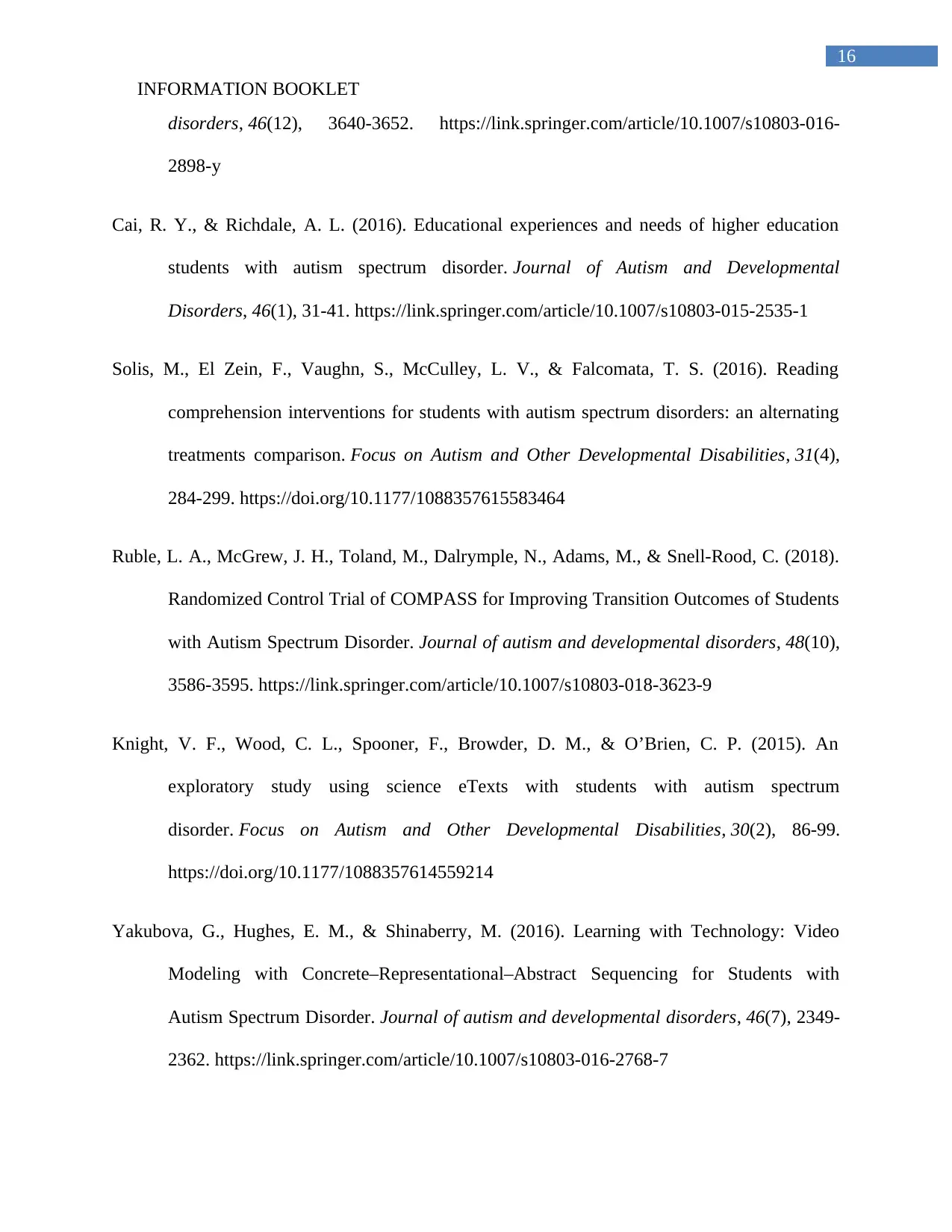
16
INFORMATION BOOKLET
disorders, 46(12), 3640-3652. https://link.springer.com/article/10.1007/s10803-016-
2898-y
Cai, R. Y., & Richdale, A. L. (2016). Educational experiences and needs of higher education
students with autism spectrum disorder. Journal of Autism and Developmental
Disorders, 46(1), 31-41. https://link.springer.com/article/10.1007/s10803-015-2535-1
Solis, M., El Zein, F., Vaughn, S., McCulley, L. V., & Falcomata, T. S. (2016). Reading
comprehension interventions for students with autism spectrum disorders: an alternating
treatments comparison. Focus on Autism and Other Developmental Disabilities, 31(4),
284-299. https://doi.org/10.1177/1088357615583464
Ruble, L. A., McGrew, J. H., Toland, M., Dalrymple, N., Adams, M., & Snell-Rood, C. (2018).
Randomized Control Trial of COMPASS for Improving Transition Outcomes of Students
with Autism Spectrum Disorder. Journal of autism and developmental disorders, 48(10),
3586-3595. https://link.springer.com/article/10.1007/s10803-018-3623-9
Knight, V. F., Wood, C. L., Spooner, F., Browder, D. M., & O’Brien, C. P. (2015). An
exploratory study using science eTexts with students with autism spectrum
disorder. Focus on Autism and Other Developmental Disabilities, 30(2), 86-99.
https://doi.org/10.1177/1088357614559214
Yakubova, G., Hughes, E. M., & Shinaberry, M. (2016). Learning with Technology: Video
Modeling with Concrete–Representational–Abstract Sequencing for Students with
Autism Spectrum Disorder. Journal of autism and developmental disorders, 46(7), 2349-
2362. https://link.springer.com/article/10.1007/s10803-016-2768-7
INFORMATION BOOKLET
disorders, 46(12), 3640-3652. https://link.springer.com/article/10.1007/s10803-016-
2898-y
Cai, R. Y., & Richdale, A. L. (2016). Educational experiences and needs of higher education
students with autism spectrum disorder. Journal of Autism and Developmental
Disorders, 46(1), 31-41. https://link.springer.com/article/10.1007/s10803-015-2535-1
Solis, M., El Zein, F., Vaughn, S., McCulley, L. V., & Falcomata, T. S. (2016). Reading
comprehension interventions for students with autism spectrum disorders: an alternating
treatments comparison. Focus on Autism and Other Developmental Disabilities, 31(4),
284-299. https://doi.org/10.1177/1088357615583464
Ruble, L. A., McGrew, J. H., Toland, M., Dalrymple, N., Adams, M., & Snell-Rood, C. (2018).
Randomized Control Trial of COMPASS for Improving Transition Outcomes of Students
with Autism Spectrum Disorder. Journal of autism and developmental disorders, 48(10),
3586-3595. https://link.springer.com/article/10.1007/s10803-018-3623-9
Knight, V. F., Wood, C. L., Spooner, F., Browder, D. M., & O’Brien, C. P. (2015). An
exploratory study using science eTexts with students with autism spectrum
disorder. Focus on Autism and Other Developmental Disabilities, 30(2), 86-99.
https://doi.org/10.1177/1088357614559214
Yakubova, G., Hughes, E. M., & Shinaberry, M. (2016). Learning with Technology: Video
Modeling with Concrete–Representational–Abstract Sequencing for Students with
Autism Spectrum Disorder. Journal of autism and developmental disorders, 46(7), 2349-
2362. https://link.springer.com/article/10.1007/s10803-016-2768-7
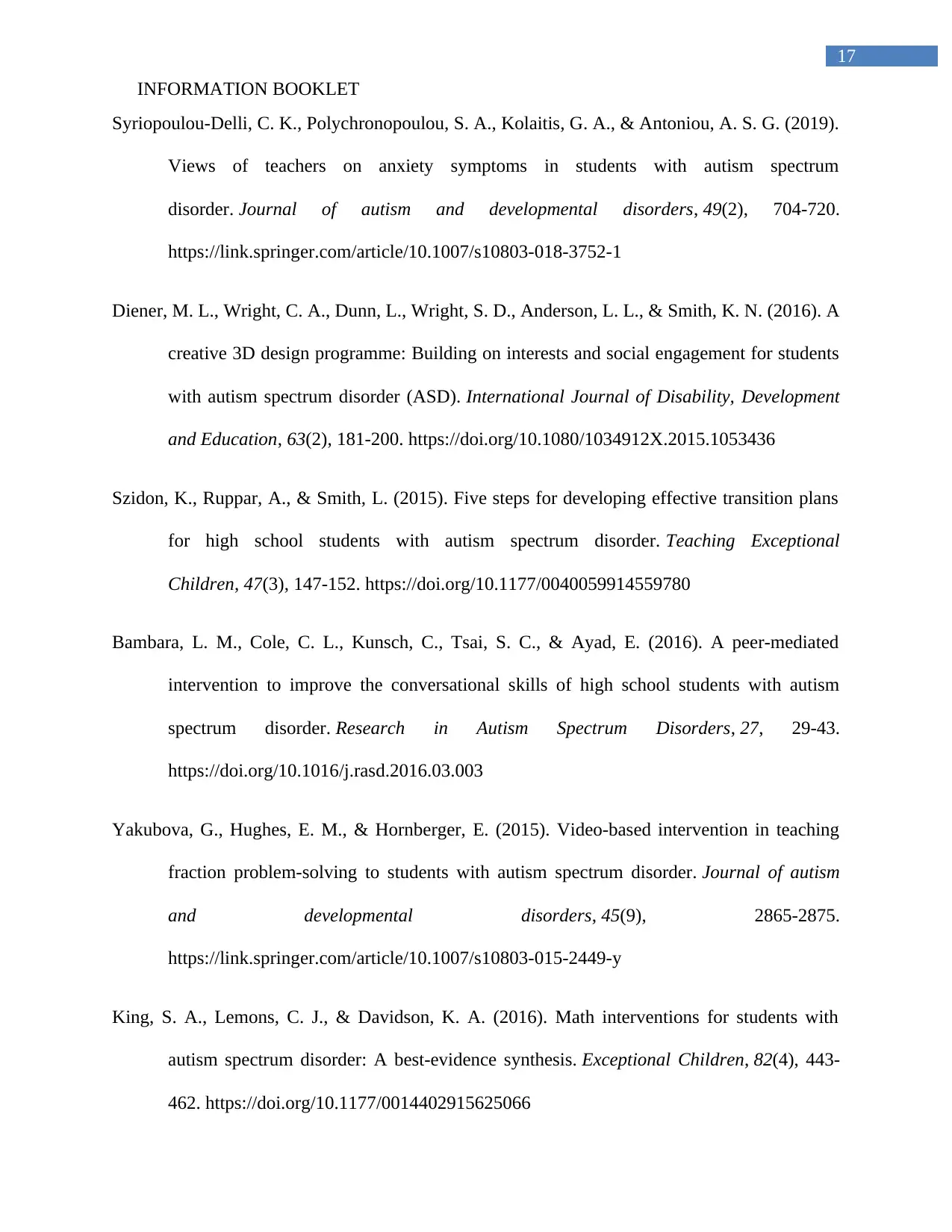
17
INFORMATION BOOKLET
Syriopoulou-Delli, C. K., Polychronopoulou, S. A., Kolaitis, G. A., & Antoniou, A. S. G. (2019).
Views of teachers on anxiety symptoms in students with autism spectrum
disorder. Journal of autism and developmental disorders, 49(2), 704-720.
https://link.springer.com/article/10.1007/s10803-018-3752-1
Diener, M. L., Wright, C. A., Dunn, L., Wright, S. D., Anderson, L. L., & Smith, K. N. (2016). A
creative 3D design programme: Building on interests and social engagement for students
with autism spectrum disorder (ASD). International Journal of Disability, Development
and Education, 63(2), 181-200. https://doi.org/10.1080/1034912X.2015.1053436
Szidon, K., Ruppar, A., & Smith, L. (2015). Five steps for developing effective transition plans
for high school students with autism spectrum disorder. Teaching Exceptional
Children, 47(3), 147-152. https://doi.org/10.1177/0040059914559780
Bambara, L. M., Cole, C. L., Kunsch, C., Tsai, S. C., & Ayad, E. (2016). A peer-mediated
intervention to improve the conversational skills of high school students with autism
spectrum disorder. Research in Autism Spectrum Disorders, 27, 29-43.
https://doi.org/10.1016/j.rasd.2016.03.003
Yakubova, G., Hughes, E. M., & Hornberger, E. (2015). Video-based intervention in teaching
fraction problem-solving to students with autism spectrum disorder. Journal of autism
and developmental disorders, 45(9), 2865-2875.
https://link.springer.com/article/10.1007/s10803-015-2449-y
King, S. A., Lemons, C. J., & Davidson, K. A. (2016). Math interventions for students with
autism spectrum disorder: A best-evidence synthesis. Exceptional Children, 82(4), 443-
462. https://doi.org/10.1177/0014402915625066
INFORMATION BOOKLET
Syriopoulou-Delli, C. K., Polychronopoulou, S. A., Kolaitis, G. A., & Antoniou, A. S. G. (2019).
Views of teachers on anxiety symptoms in students with autism spectrum
disorder. Journal of autism and developmental disorders, 49(2), 704-720.
https://link.springer.com/article/10.1007/s10803-018-3752-1
Diener, M. L., Wright, C. A., Dunn, L., Wright, S. D., Anderson, L. L., & Smith, K. N. (2016). A
creative 3D design programme: Building on interests and social engagement for students
with autism spectrum disorder (ASD). International Journal of Disability, Development
and Education, 63(2), 181-200. https://doi.org/10.1080/1034912X.2015.1053436
Szidon, K., Ruppar, A., & Smith, L. (2015). Five steps for developing effective transition plans
for high school students with autism spectrum disorder. Teaching Exceptional
Children, 47(3), 147-152. https://doi.org/10.1177/0040059914559780
Bambara, L. M., Cole, C. L., Kunsch, C., Tsai, S. C., & Ayad, E. (2016). A peer-mediated
intervention to improve the conversational skills of high school students with autism
spectrum disorder. Research in Autism Spectrum Disorders, 27, 29-43.
https://doi.org/10.1016/j.rasd.2016.03.003
Yakubova, G., Hughes, E. M., & Hornberger, E. (2015). Video-based intervention in teaching
fraction problem-solving to students with autism spectrum disorder. Journal of autism
and developmental disorders, 45(9), 2865-2875.
https://link.springer.com/article/10.1007/s10803-015-2449-y
King, S. A., Lemons, C. J., & Davidson, K. A. (2016). Math interventions for students with
autism spectrum disorder: A best-evidence synthesis. Exceptional Children, 82(4), 443-
462. https://doi.org/10.1177/0014402915625066
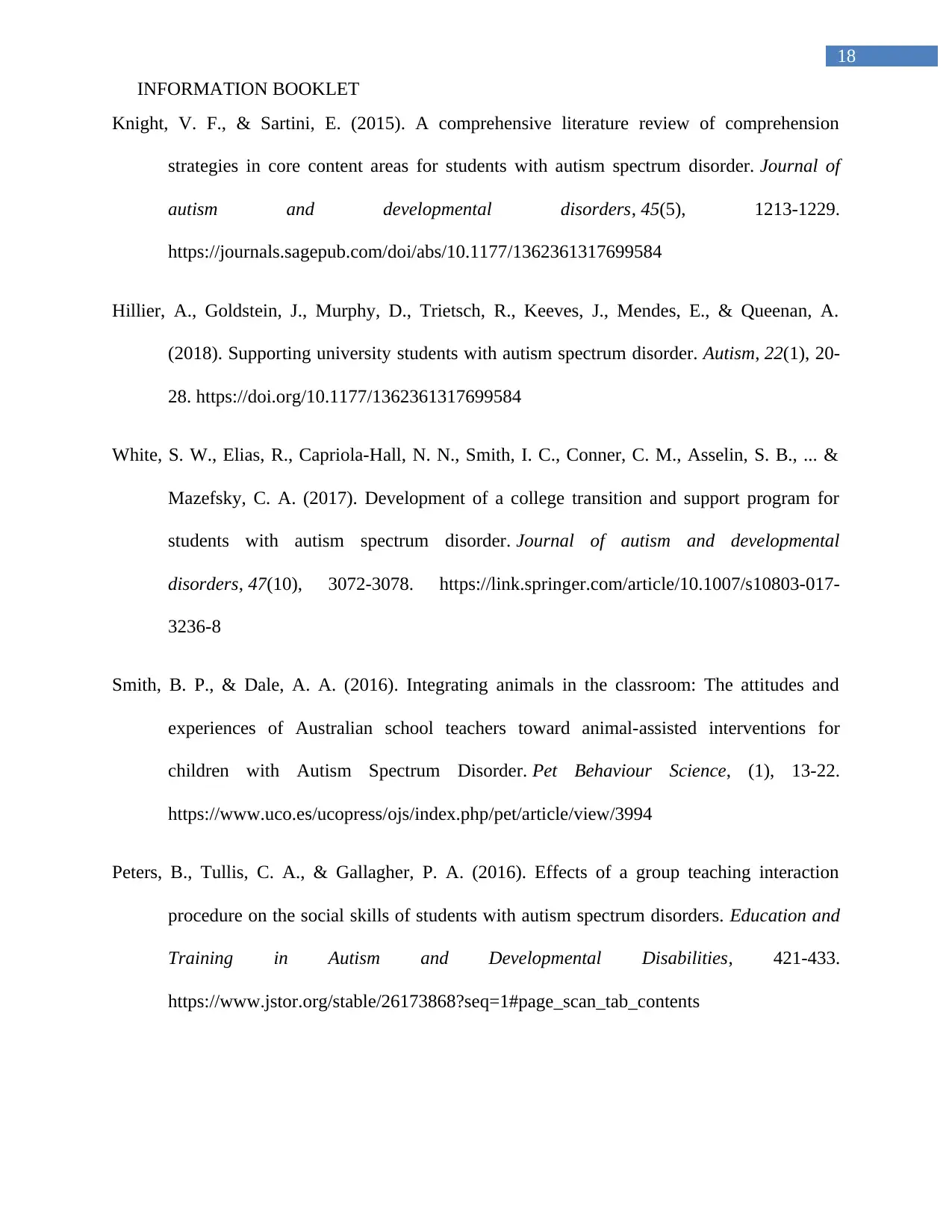
18
INFORMATION BOOKLET
Knight, V. F., & Sartini, E. (2015). A comprehensive literature review of comprehension
strategies in core content areas for students with autism spectrum disorder. Journal of
autism and developmental disorders, 45(5), 1213-1229.
https://journals.sagepub.com/doi/abs/10.1177/1362361317699584
Hillier, A., Goldstein, J., Murphy, D., Trietsch, R., Keeves, J., Mendes, E., & Queenan, A.
(2018). Supporting university students with autism spectrum disorder. Autism, 22(1), 20-
28. https://doi.org/10.1177/1362361317699584
White, S. W., Elias, R., Capriola-Hall, N. N., Smith, I. C., Conner, C. M., Asselin, S. B., ... &
Mazefsky, C. A. (2017). Development of a college transition and support program for
students with autism spectrum disorder. Journal of autism and developmental
disorders, 47(10), 3072-3078. https://link.springer.com/article/10.1007/s10803-017-
3236-8
Smith, B. P., & Dale, A. A. (2016). Integrating animals in the classroom: The attitudes and
experiences of Australian school teachers toward animal-assisted interventions for
children with Autism Spectrum Disorder. Pet Behaviour Science, (1), 13-22.
https://www.uco.es/ucopress/ojs/index.php/pet/article/view/3994
Peters, B., Tullis, C. A., & Gallagher, P. A. (2016). Effects of a group teaching interaction
procedure on the social skills of students with autism spectrum disorders. Education and
Training in Autism and Developmental Disabilities, 421-433.
https://www.jstor.org/stable/26173868?seq=1#page_scan_tab_contents
INFORMATION BOOKLET
Knight, V. F., & Sartini, E. (2015). A comprehensive literature review of comprehension
strategies in core content areas for students with autism spectrum disorder. Journal of
autism and developmental disorders, 45(5), 1213-1229.
https://journals.sagepub.com/doi/abs/10.1177/1362361317699584
Hillier, A., Goldstein, J., Murphy, D., Trietsch, R., Keeves, J., Mendes, E., & Queenan, A.
(2018). Supporting university students with autism spectrum disorder. Autism, 22(1), 20-
28. https://doi.org/10.1177/1362361317699584
White, S. W., Elias, R., Capriola-Hall, N. N., Smith, I. C., Conner, C. M., Asselin, S. B., ... &
Mazefsky, C. A. (2017). Development of a college transition and support program for
students with autism spectrum disorder. Journal of autism and developmental
disorders, 47(10), 3072-3078. https://link.springer.com/article/10.1007/s10803-017-
3236-8
Smith, B. P., & Dale, A. A. (2016). Integrating animals in the classroom: The attitudes and
experiences of Australian school teachers toward animal-assisted interventions for
children with Autism Spectrum Disorder. Pet Behaviour Science, (1), 13-22.
https://www.uco.es/ucopress/ojs/index.php/pet/article/view/3994
Peters, B., Tullis, C. A., & Gallagher, P. A. (2016). Effects of a group teaching interaction
procedure on the social skills of students with autism spectrum disorders. Education and
Training in Autism and Developmental Disabilities, 421-433.
https://www.jstor.org/stable/26173868?seq=1#page_scan_tab_contents
Paraphrase This Document
Need a fresh take? Get an instant paraphrase of this document with our AI Paraphraser

19
INFORMATION BOOKLET
INFORMATION BOOKLET
1 out of 20
Related Documents
Your All-in-One AI-Powered Toolkit for Academic Success.
+13062052269
info@desklib.com
Available 24*7 on WhatsApp / Email
![[object Object]](/_next/static/media/star-bottom.7253800d.svg)
Unlock your academic potential
© 2024 | Zucol Services PVT LTD | All rights reserved.





